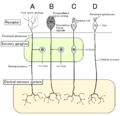Nociceptor
Article about nociceptors, the sensory neurons that respond to damaging or potentially damaging stimuli.
Nociceptors are specialized sensory neurons that respond to potentially damaging stimuli by sending signals to the spinal cord and brain. This process, known as nociception, is the first step in the perception of pain. Nociceptors are found in the skin, joints, and some internal organs, and they play a crucial role in the body's ability to detect and respond to harmful stimuli.
Structure and Function[edit]
Nociceptors are a type of sensory neuron with free nerve endings that are distributed throughout the body. They are activated by mechanical, thermal, and chemical stimuli that are intense enough to potentially cause tissue damage. When activated, nociceptors generate electrical signals that travel along the afferent nerve fibers to the central nervous system.
Nociceptors can be classified based on the type of stimuli they respond to:
- Mechanical nociceptors respond to strong pressure or mechanical deformation.
- Thermal nociceptors are activated by extreme temperatures, either hot or cold.
- Chemical nociceptors respond to chemical stimuli, such as those released by damaged tissue or inflammatory mediators.
Types of Nociceptors[edit]
Nociceptors can also be categorized based on the type of nerve fibers they are associated with:
- A-delta fibers are myelinated fibers that conduct signals rapidly and are responsible for the initial sharp pain sensation.
- C fibers are unmyelinated fibers that conduct signals more slowly and are associated with the dull, throbbing pain that follows the initial injury.
Role in Pain Perception[edit]
The activation of nociceptors is the first step in the pain pathway. Once activated, the signals are transmitted to the dorsal horn of the spinal cord, where they are processed and relayed to the brain. The brain interprets these signals as pain, which serves as a protective mechanism to alert the body to potential harm.
Clinical Significance[edit]
Understanding nociceptors and their function is crucial in the field of pain management. Conditions such as neuropathic pain, chronic pain, and inflammatory pain involve alterations in nociceptor function. Research into nociceptors has led to the development of various analgesic drugs and treatments aimed at modulating nociceptor activity to alleviate pain.
Also see[edit]

-
Structure of sensory system (4 models) E
Ad. Transform your life with W8MD's Budget GLP-1 injections from $75


W8MD offers a medical weight loss program to lose weight in Philadelphia. Our physician-supervised medical weight loss provides:
- Weight loss injections in NYC (generic and brand names):
- Zepbound / Mounjaro, Wegovy / Ozempic, Saxenda
- Most insurances accepted or discounted self-pay rates. We will obtain insurance prior authorizations if needed.
- Generic GLP1 weight loss injections from $75 for the starting dose.
- Also offer prescription weight loss medications including Phentermine, Qsymia, Diethylpropion, Contrave etc.
NYC weight loss doctor appointmentsNYC weight loss doctor appointments
Start your NYC weight loss journey today at our NYC medical weight loss and Philadelphia medical weight loss clinics.
- Call 718-946-5500 to lose weight in NYC or for medical weight loss in Philadelphia 215-676-2334.
- Tags:NYC medical weight loss, Philadelphia lose weight Zepbound NYC, Budget GLP1 weight loss injections, Wegovy Philadelphia, Wegovy NYC, Philadelphia medical weight loss, Brookly weight loss and Wegovy NYC
|
WikiMD's Wellness Encyclopedia |
| Let Food Be Thy Medicine Medicine Thy Food - Hippocrates |
Medical Disclaimer: WikiMD is not a substitute for professional medical advice. The information on WikiMD is provided as an information resource only, may be incorrect, outdated or misleading, and is not to be used or relied on for any diagnostic or treatment purposes. Please consult your health care provider before making any healthcare decisions or for guidance about a specific medical condition. WikiMD expressly disclaims responsibility, and shall have no liability, for any damages, loss, injury, or liability whatsoever suffered as a result of your reliance on the information contained in this site. By visiting this site you agree to the foregoing terms and conditions, which may from time to time be changed or supplemented by WikiMD. If you do not agree to the foregoing terms and conditions, you should not enter or use this site. See full disclaimer.
Credits:Most images are courtesy of Wikimedia commons, and templates, categories Wikipedia, licensed under CC BY SA or similar.
Translate this page: - East Asian
中文,
日本,
한국어,
South Asian
हिन्दी,
தமிழ்,
తెలుగు,
Urdu,
ಕನ್ನಡ,
Southeast Asian
Indonesian,
Vietnamese,
Thai,
မြန်မာဘာသာ,
বাংলা
European
español,
Deutsch,
français,
Greek,
português do Brasil,
polski,
română,
русский,
Nederlands,
norsk,
svenska,
suomi,
Italian
Middle Eastern & African
عربى,
Turkish,
Persian,
Hebrew,
Afrikaans,
isiZulu,
Kiswahili,
Other
Bulgarian,
Hungarian,
Czech,
Swedish,
മലയാളം,
मराठी,
ਪੰਜਾਬੀ,
ગુજરાતી,
Portuguese,
Ukrainian
